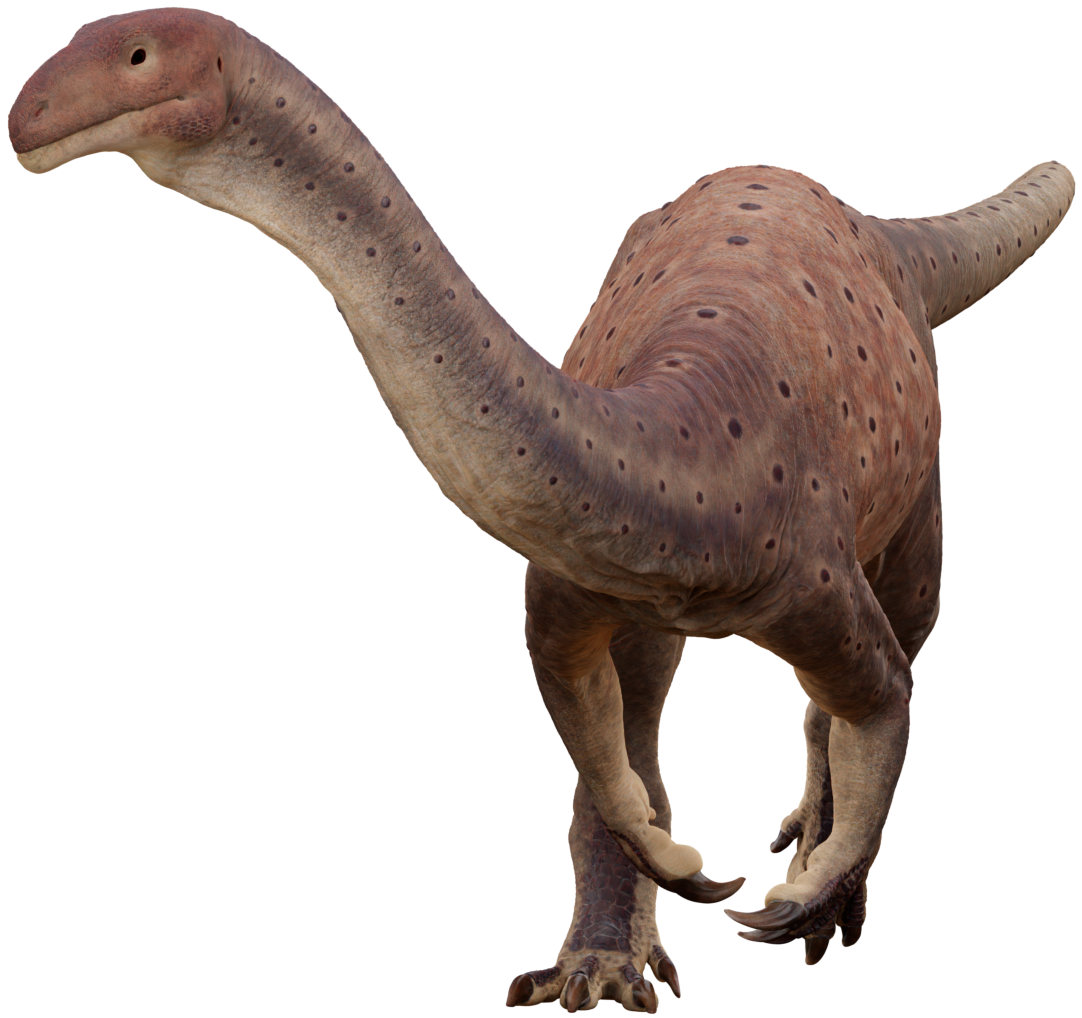Browser of the Antarctic Forests
Discovered in the 1990s, this sauropodomorph from the Early Jurassic was one of the first Antarctic dinosaurs ever found and gives a rare glimpse into what the frozen continent was like before it froze.
Overview: Today, Antarctica is a land of unending winter, with permanent ice sheets over a mile thick. But 186 million years ago, it was a lush forest. Browsing the foliage of this forest was the large sauropodomorph Glacialisaurus. Discovered in the 1990s by William Hammer and his field team, it was painstakingly extracted from a harsh and unforgiving landscape. It was named in 2007 by Nathan Smith and Diego Pol. Glacialisaurus was one of the first Antarctic dinosaurs ever found and gives a rare glimpse into what the frozen continent was like before it became forever locked in ice.
Discovery: Gracialisaurus hammeri was discovered on Mount Kirkpatrick in the Central Transantarctic Mountains of Antartica, some 4,100 m (13,500 ft) above sea level. It was preserved in the Early Jurassic rocks of the Hanson Formation, dating to between 186 and 182 million years ago. Its discoverers were a field team from Augustana College, led by William R. Hammer. It was painstakingly excavated from the harsh and unforgiving Antarctic landscape between 1990 and 1991, after which the remains, which included very incomplete material from two individuals, were sent to the Field Museum of Natural History in Chicago. It was officially reported in 1994, but wasn’t given a name until 2007 when it was described by Nathan Smith and Diego Pol. The name Glacialisaurus means “Icy Lizard”, derived from Latin glacialis, meaning “icy”, and Greek sauros, meaning “lizard”. The species name honors its original discoverer, William Hammer. At the time of discovery, it was one of the first dinosaurs discovered in Antarctica. Specifically, it was the second Antarctic dinosaur discovered, tied with Cryolophosaurs which was discovered at the same time at the same site. The first was the akylosaur Anarctopelta, discovered a few years previous to Glacialisaurus in 1986. Glacialisaurus remains one of only a handful of Antarctic dinosaurs known, and along with Cryolophosaurus it is one of only two named dinosaurs known from Antarctica in the Jurassic Period.
Evolution and Physical Description: Glacialisaurus was a sauropodomorph in the family Massospondylidae. Massospondylids were “prosauropod” grade sauropodomorphs, more primitive than true sauropods. Glacialosaurus and its kin were approaching sauropod proportions, including having a long neck and small head, and a large barrel-shaped body. However, Glacialosaurus was probably still at least a facultative biped (an animal that usually stands on four legs but which can switch to two), and though it was large by herbivore standards of its time, achieving lengths of 6-7.6 meters (20-25 ft) and weighing in at around 3.6-5.4 tonnes (4-6 tons), it was still far from the sizes which true sauropods would later achieve. Glacialisaurus had leaf shaped teeth, indicating an herbivorous diet, and a large thumb claw on each hand, which would have been used in self-defense.
Ecology: 186 million years ago, the Earth’s climate was much warmer than in is now, including at the poles, meaning Antarctica had no permanent ice caps. Additionally, the region where Glacialisaurus lived was at that time some 1,000 km (621 mi) farther north than it is today. Thus, while other parts of Antarctica would have been colder, the region in which Glacialisaurus lived was decently warm (though still cool by global standards), and fully foliated by plants which included ferns, horsetails, and conifers. In both climate and in many aspects of flora, the habitat of Glacialisaurus probably resembled the open woodlands of modern-day North Island, New Zealand. Glacialisaurus was the largest animal in its environment and its long neck and (probable) ability to stand on two legs meant that it was probably an early high browser, a niche some true sauropods like Brachiosaurus would later take to the extreme. It lived alongside rat-sized relatives of mammals called tritylodonts, and at least one type of small pterosaur, a relative of the European Dimorphodon. But the king of the south was the large theropod Cryolophosaurus, which reached 6–7 meters (20–23 ft) in length and weighed 350–465 kilograms (772–1,025 lb). It was undoubtedly the primary predator (and currently the only known predator) of Glacialisaurus. The prosauropod was not defenseless, however, as it had the weight advantage, and its thumb spikes were likely capable of seriously injuring a predator. This being the case, Cryolophosaurus may have preferred to hunt juvenile and sick Glacialisaurus in order to avoid injury from the healthy adults. Glacialosaurus lived in a geologically active environment with frequent volcanic activity caused by the breakup of Pangea. Frequent ash falls probably meant rich volcanic soil, great for plant growth, but it also meant that animals like Glacialisaurus had to be adapted to deal with occasional environmental disturbances when large eruptions happened.
Extinction and Legacy: The cause of Glacialosaurus’ eventual extinction is unknown. We know that in the middle Jurassic the basal sauropodomorphs or “prosauropods” were replaced across the world by the true sauropods, but due to a complete absence of known or described fossils from Antarctica during that time, we do not know when Glacialosaurus went extinct or what creatures replaced it. Glacialisaurus can be seen at the Field Museum of Natural History in Chicago, IL, USA.
Glacialisaurus FAQ
Glacialisaurus size / How big was Glacialisaurus?
See height, weight, and length.
Glacialisaurus height / How tall was Glacialisaurus?
Glacialisaurus may have been around 2 meters (8.2 ft) tall in regular standing position but could likely have been taller when feeding by shifting to a more vertically oriented posture.
Glacialisaurus weight / How much did a Glacialisaurus weigh?
Glacialisaurus probably weighed about 3.6-5.4 tonnes (4-6 US tons).
How long was Glacialisaurus?
Glacialisaurus grew 6.2 meters (20.34 ft) in length.
What did Glacialisaurus eat?
Glacialisaurus ate plants and may have been a browser of small trees.
What is Glacialisaurus closest living relative?
Like all dinosaurs, the closest relatives of Glacialisaurus are the only surviving lineage of dinosaurs today, the birds. Crocodilians, while not dinosaurs themselves, are also more distant cousins of dinosaurs.
Glacialisaurus family members / Glacialisaurus family / What kind of dinosaur was Glacialisaurus?
Glacialisaurus was an early sauropodomorph (sauropods and their earlier relatives) in the family Massospondylidae, making it closer to true sauropods than many earlier sauropodomorphs like Panphagia and Plateosaurus.
Where did Glacialisaurus live? / Where was Glacialisaurus found?
Glacialisaurus lived in Antarctica and is the first dinosaur discovered on the continent!
When did Glacialisaurus live?
Glacialisaurus lived about 186-182 million years ago during the Early Jurassic Period.
What does Glacialisaurus mean? / Glacialisaurus name meaning
Glacialisaurus means “Icy Lizard” in reference to the cold, icy continent on which it was discovered.

